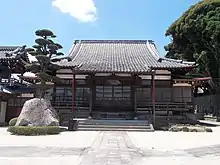Kōshū-ji (Fukuoka)
Kōshū-ji (興宗寺), also pronounced as Kōsō-ji, is a Sōtō Zen Buddhist temple in Minami-ku, Fukuoka, Japan. The temple stands under the cavern of Takamiya where the old tombs existed.[1]
| Kōshū-ji 興宗寺 | |
|---|---|
 | |
| Religion | |
| Affiliation | Sōtō |
| Location | |
| Location | 2-22-11, Terazuka, Minami-ku, Fukuoka Fukuoka Prefecture 815-0074 |
| Country | Japan |
| Geographic coordinates | 33°33′26.60″N 130°24′6.19″E |
| Architecture | |
| Founder | Tandō Chōzen |
| Completed | 1693 |
History
According to tradition, Kuroda Nagamasa tried to use the carve stone to build the Fukuoka Castle, but Kannon appeared in his dream and told him to stop construction. He later found out that a Kannon image was carved in the stone. He decided to stop working and built the hall of worship on the temple grounds.
Once the temple was destroyed, however in 1693 the main hall was rebuilt by Tandō Chōzen, the priest of Chōen-ji in Chūō-ku, Fukuoka.[2]
It was originally located in Kumade Village, Onga District what is now called Yahatanishi-ku, Kitakyūshū. It belonged to Ryūshō-ji in the same district, but was abandoned. Afterwards Tandō took over the temple and relocated the chapel to a new site in the Terazuka district to the south of the castle.[2]
Anakannon
Anakannon (穴観音) is an ancient circular tomb located southward on the right side of the hill on the Kōshū-ji temple grounds. The estimated diameter of the hill is approximately 20 metres. The main part is a double-chambered site stone chamber that opens southward, and is from the late Kofun period in the 6th century. The stone chamber is a made of huge rocks that are one of the largest megalithic walls in Fukuoka.[3] Amitābha is carved in front of the back of stone chamber, and Kannon and Mahasthamaprapta are both on the left and right.[3] The author and the production date are unknown, but it is commonly called Anakannon because of its form.[3]
There were many old burial mounds in the Terazuka area, but it was told that some of the stones were removed from the stone walls when Fukuoka Castle was built.[3]
The graves of forty-seven Rōnin
In 1935, Zenjirō Kihara, a private investor, invested his private property and established the graves of forty-seven Rōnin on the temple grounds. It is a sense of purpose for health development of youth and promotion of national consciousness. It is the same style as at Sengaku-ji in Tokyo, of topographic arrangement, of grave markers etc.[2]
Each year on December 14, the temple holds a festival commemorating the 47 Rōnin.
Gallery

 Bell tower and Main Hall
Bell tower and Main Hall 47 Rōnin graves
47 Rōnin graves Anakannon
Anakannon Relief images of Kannon carved into one of the Hyakuzuka (百塚) rocks
Relief images of Kannon carved into one of the Hyakuzuka (百塚) rocks
Notes
- 穴観音興宗禅寺 [Anakannon Kōshūzen-ji] (in Japanese). fukuoka-good.com. Retrieved September 1, 2019.
- [興宗寺[曹洞宗][福岡県福岡市南区寺塚2丁目22-11]-お寺めぐりの友 [Kōshū-ji] (in Japanese). hakataboy.com. Retrieved September 1, 2019.
- 寺塚穴観音古墳 [Terazuka Anakannon Kofun] (in Japanese). city of Fukuoka. Retrieved September 1, 2019.
External links
- HoteGuru Sightseeing Guide in Japanese (some English)